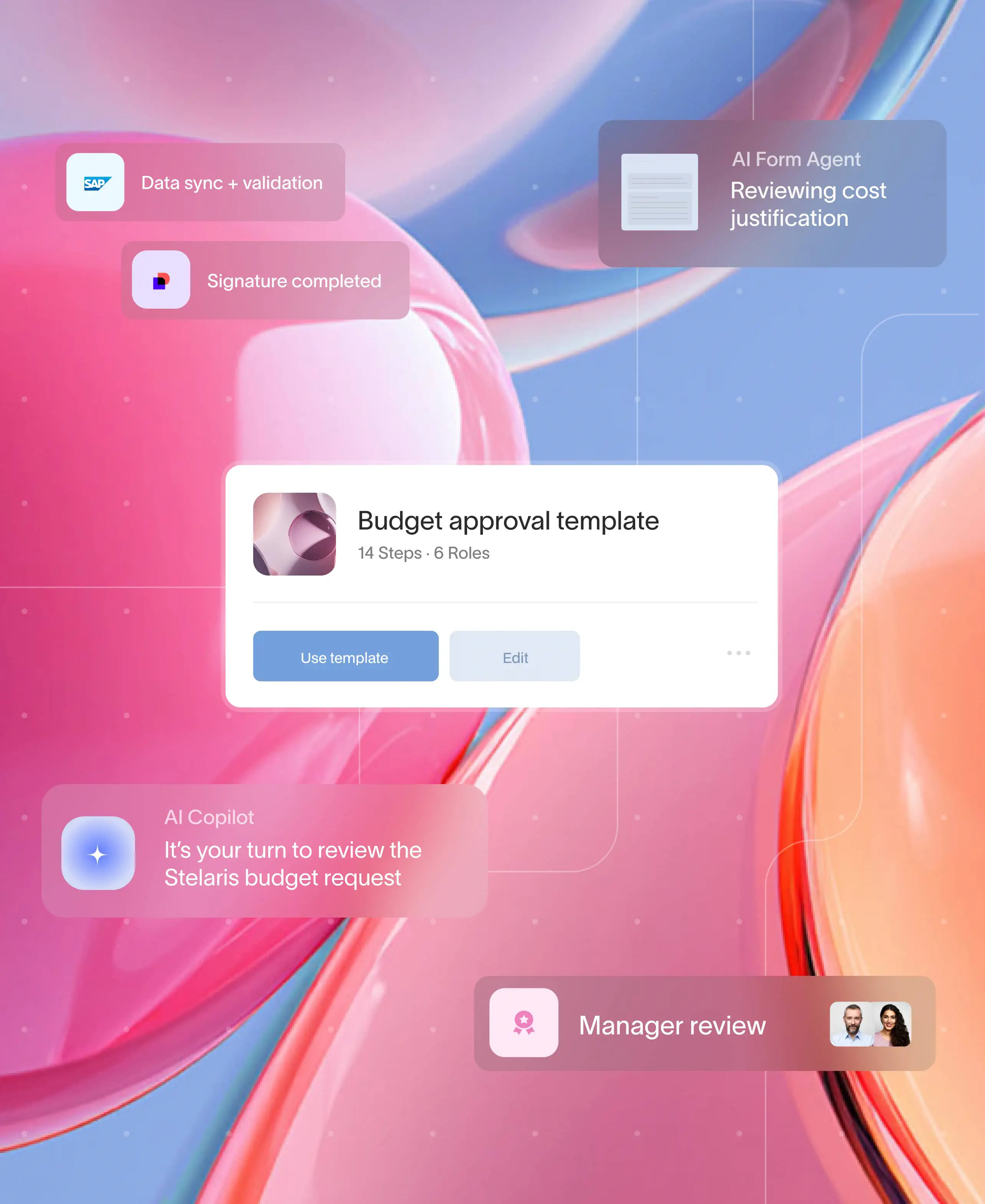
At a glance
Contracts are the backbone of every business relationship. They define responsibilities, set expectations, and protect organizations from risk. Yet despite their importance, the way contracts are managed often creates friction instead of clarity. Teams lose time chasing signatures across email threads, multiple stakeholders weigh in without a clear process, and deadlines slip by unnoticed. According to World Commerce & Contracting, poor contract management can erode value equivalent to 9% of annual revenue — a staggering cost for inefficiency.
A contract management workflow addresses this by bringing structure, accountability, and visibility to every stage of the contract lifecycle. Unlike ad hoc methods, a workflow ensures contracts move from drafting to renewal without unnecessary delays. But not all platforms are created equal. Many orchestration tools were built for internal processes only, or operate as “headless” systems that lack a client-facing experience. Real-world contract management demands more — coordination between internal teams and external stakeholders in a seamless, auditable process.
This guide explores what contract management workflows are, why traditional approaches fail, and what to look for in a modern orchestration platform. By the end, you’ll know how to design workflows that reduce bottlenecks, ensure compliance, and create a better experience for every stakeholder.
What is a contract management workflow
A contract management workflow is the structured process organizations use for contract creation, drafting, reviewing, approving, executing, and tracking contracts. Instead of relying on disconnected tools or email, a workflow unifies the lifecycle into one orchestrated flow.
Think of it as the “map” for how contracts move through your organization. It defines who drafts, who reviews, who signs, and how the contract is stored and monitored. A workflow ensures that nothing gets lost in translation and that every participant — whether a sales rep, a finance approver, or an external client — knows exactly when it’s their turn to act.
The difference between companies with and without defined workflows is night and day. Without one, contracts pile up in inboxes, errors slip through unchecked, and renewals are forgotten. With one, contracts become a repeatable, reliable process that minimizes risk and accelerates business outcomes.
The stages of a contract management workflow
While every business has its own variations, most contract processes and workflows follow a predictable set of stages:
Drafting and authoring begins with creating a contract, often using a template. This step requires input from legal teams and business stakeholders to ensure terms are accurate and compliant.
Negotiation and redlining follows, where internal teams and external parties collaborate on revisions. Without a structured contract negotiation workflow and proper version control , this stage is where contracts often stall. Multiple versions circulate, comments get lost, and decisions take longer than necessary.
Approvals and compliance checks are essential before execution. Internal stakeholders — often from legal, finance, or compliance — need to confirm the contract meets company standards and regulatory requirements. To see how orchestration can reduce bottlenecks at this stage, explore workflow for contract management.
Signatures and execution formalize the agreement. Digital signatures have become the norm, but many businesses still face delays when external parties don’t have an easy way to sign.
Storage, monitoring, and renewals close the loop. Contracts must be stored in a secure, accessible repository, tracked for milestones, and renewed or terminated on time.
When these stages are connected through workflow contract management automation, contracts flow smoothly. Without orchestration, each handoff becomes a potential bottleneck.
The evolution of contract management workflows
Contract management has changed dramatically over the last two decades. In the past, most organizations relied on manual processes: printed documents, physical signatures, and spreadsheets to track deadlines. These methods were slow and error-prone, but they persisted because alternatives didn’t exist.
The first wave of digital transformation introduced basic contract lifecycle management (CLM) tools. These platforms offered digital repositories and simple tracking, but they were largely internal-facing. External parties were still managed through email attachments and PDF signatures, which meant the most critical bottlenecks remained unresolved.
Today, businesses need more than just automation — they need orchestration. Orchestration platforms do more than digitize internal steps. They coordinate multi-party, multi-step workflows that involve clients, vendors, and partners. Modern orchestration incorporates AI nudges, auditability, and role-based permissions to ensure every contract action is clear, accountable, and secure.
This evolution reflects a broader shift: contracts are no longer just back-office documents. They are front-and-center experiences that shape client trust and business efficiency.
Why traditional contract workflows break down
Despite these advancements, many organizations still rely on outdated methods. The pain points are consistent across industries:
- Email overload: Approval chains buried in inboxes create confusion over who owes the next step.
- Version chaos: Multiple drafts circulate, leading to errors and wasted time reconciling changes.
- External bottlenecks: Clients, vendors, and partners struggle to engage when workflows are designed only for internal teams.
- Missed renewals: Without visibility into deadlines, businesses risk revenue leakage or compliance violations.
Even some modern platforms fail because they were built for internal-only workflows or designed as headless systemsthat require significant IT development to surface. These solutions may automate tasks, but they don’t solve the real-world challenge of orchestrating external parties in a transparent, professional way.
To understand the difference, see examples of an efficient contract workflow compared to manual methods.
Real-world examples of contract workflows
Contract management workflows appear in nearly every industry. Procurement teams manage supplier agreements that require approvals across finance and legal. Law firms draft agreements that go through multiple revisions before execution. Financial institutions onboard vendors with strict compliance requirements.
Each of these can be mapped as a contract management workflow process. To see one in action, explore this contract management example that shows how internal teams and external parties collaborate from draft to renewal.
This mirrors the broader contracts process, where orchestration ensures nothing falls through the cracks.
What to look for in a contract management workflow platform
Not all workflow tools address the real challenges of contract management. When evaluating platforms, it’s important to look for solutions that can deliver the following:
- Support for external stakeholders so clients, vendors, and partners can take action without friction.
- A clear, user-friendly interface that eliminates the need for email chains and attachments.
- Audit trails and compliance tracking that provide visibility into every decision and signature.
- Secure collaboration tools including file sharing, messaging, and annotations.
- Intelligent nudges and reminders that ensure no step stalls for lack of follow-up.
Moxo’s workflow orchestration platform was designed around these requirements. Unlike internal-only systems, it provides a client-facing experience where external stakeholders can collaborate securely. By combining automation with human-in-the-loop approvals and audit-ready trails, Moxo enables businesses to orchestrate contracts with confidence.
Benefits of orchestrated contract management workflows
The value of orchestrated workflows is clear across organizations of every size:
- Faster cycle times mean deals close sooner and revenue is recognized faster.
- A more professional client experience strengthens relationships and builds trust.
- Reduced operational overhead frees staff from chasing approvals.
- Improved compliance and visibility ensures leadership always knows where contracts stand.
By implementing a workflow designed for both internal teams and external parties, organizations can transform contracts from a bottleneck into a strategic enabler. To see how this plays out in practice, explore Moxo’s client-facing workflow solutions.
Contract workflows across industries
Contract management workflows aren’t confined to one sector. They take different shapes depending on industry:
In procurement, supplier contracts require sign-offs from legal, finance, and operations — often while coordinating with vendors.
In legal services, firms handle client agreements that involve multiple revisions and strict compliance requirements.
In financial services, vendor onboarding and loan agreements must pass through rigorous approvals with full audit trails.
In professional services, client contracts are central to contract execution and delivering a polished brand experience, and delays can undermine credibility.
In each case, contracts involve both internal teams and external parties. Platforms that only manage internal steps leave critical gaps, which is why orchestration is essential across industries. Businesses looking to modernize can learn from how Moxo supports client onboarding and account management.
Best practices for designing a contract workflow
Organizations that succeed with contract workflows share a few habits:
Standardize with templates so contracts begin consistently and avoid errors.
Use role-based permissions to route approvals efficiently.
Embed audit trails and reporting so compliance isn’t an afterthought.
Integrate with existing systems like CRMs or finance tools to enhance the contract management process and avoid silos.
These practices not only make workflows more efficient, they also make them scalable as the organization grows.
Frequently asked questions
What is an example of a contract management workflow
A typical example is a vendor agreement that begins with a draft, passes through legal review, is approved by finance, signed by both parties, and monitored for renewal deadlines.
How do businesses typically manage contract workflows today
Many still rely on spreadsheets and email for their contract management workflow process, but these methods lead to delays, lost documents, and compliance risks. Orchestration platforms centralize the process so each step is visible and trackable.
What features should I look for in a contract management workflow platform
Look for platforms that support external stakeholders, provide a user-friendly interface, maintain audit trails, enable secure collaboration, and include built-in reminders.
How can workflow orchestration improve compliance in contract management
By logging every action — approvals, signatures, and revisions — orchestration platforms create a traceable record that protects the business and simplifies audits.
How is contract management different from contract lifecycle management (CLM)
CLM often refers to back-office systems that store and track contracts. Contract management workflows go further by orchestrating the real-time actions needed to move contracts forward, especially when external stakeholders are involved.
What industries benefit most from contract management workflows
Any business that manages multiple contracts benefits, but industries like legal, financial services, procurement, and professional services see the biggest impact because of the number of external parties involved.
Can small and mid-sized businesses benefit from contract workflows
Absolutely. Even organizations with modest contract volumes save time, reduce risk, and project professionalism by moving away from scattered manual processes.
Stay in control of every contract
When approvals are not tracked or documents are not centralized, businesses face real risks from missed renewals to compliance issues. Moxo provides full visibility, audit trails, and built-in approvals so every contract action is secure, accountable, and easy to manage. Book a 15 minute demo and discover how Moxo can help you orchestrate contract workflows that run smoothly from start to finish.





